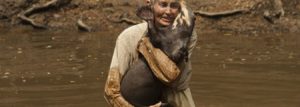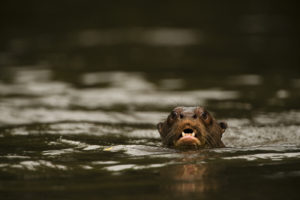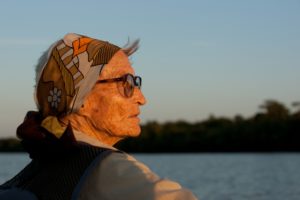The First Lady of Conservation
November 9, 2018 - 8 minutes read
Diane McTurk, who established Guyana as a Mecca for wildlife enthusiasts.
Karanambu Lodge features high on the list of essential experiences in the spectacular untamed beauty of the Rupununi. And that’s not entirely because of the delicious passion fruit rum punch, starry nights of caiman spotting on the Rupununi River or the clay-brick cottages with a cool breeze at night. It is the indomitable spirit of Ms. Diane McTurk that makes the eco-lodge a mecca for wildlife enthusiasts. David Attenborough and Gerald Durrell would definitely agree. The conservationist and authors were deeply influenced by the Rupununi and have recounted tales of staying in the iconic Karanambu Lodge.
Diane’s father, Tiny McTurk, established Karanambu in 1927 as a Balata collecting station. Balata is obtained from the natural latex of the bulletwood tree. Balata boosted the economic activity of British Guiana as worldwide demand for rubber intensified for machinery belting; to cover submarine telegraph cables. After the war, when the demand for rubber decreased, Tiny went into the cattle industry. Karanambu Ranch is over 100 square miles of wilderness. It was a sprawling land with thousands of cattle head. A passionate naturalist, Tiny helped trigger Diane’s interest in the flora and fauna of her home, the wetlands of North Rupununi in Guyana. With a home located at the edge of the Rupununi River, it was the perfect place to learn about the endemic species. After attending school in England and studying acting with classmate Maggie Smith. In 1966, Diane returned to Guyana to celebrate the country’s independence. She subsequently became the Press Officer for the Guyana Sugar Producers Association. In 1974 she moved back to England and worked as Public Relations Officer for the Savoy Hotel. In 1977 Diane returned again to her beloved Guyana and to her roots at Karanambu to take the baton of conservation and lay the foundation of mindful tourism in the region. It was 1983, when she opened the ranch to paying adventurous travellers to come and witness the unimaginable wealth of nature in her backyard.
Apart from ecotourism, Diane’s focus lay in the love and rehabilitation of several injured wildlife, especially the orphaned giant river otters. Her first otter, brought to her as a Christmas gift, she promptly named “Frankincense”, Frankie for short, because he was a ‘Kingly gift at Christmas’. It was by necessity that she became the world renowned expert on the Giant River Otter, by raising over the years more than 50 otters who had been abandoned or injured. Her love for one special blind otter, Buddy, is legendary and has been extolled and covered by several filmmakers. Clips and images of Diane with otters in the Rupununi River dominate the internet, when covering topics related to conservation in Guyana. It was not the otters alone that benefited from Diane’s life and dedication to nature. The Karanambu Trust, a charity set up in 1997 by the McTurk Family was aimed at preserving the entire Karanambu wetlands and savannahs, benefitting both the animals and the community around.
Diane focused on sustainable projects for wildlife and habitat conservation, research, and education in partnership with local communities. Her work continues even after her passing away in 2016. Karanambu still supports research in the region that in turn helps sustainable development and participation by locals. Educational and outreach programs are the backbone of activities by the Karanambu Trust. Ecotourism helps the message spread and fund the activities even now.

Giant Otter (Pteronura brasiliensis)
Stellar examples of the Trust’s work have paved the way for future conservation work in the region. For example, a female (Bel) and male (Phillip) otters were brought to Karanambu as orphaned cubs. In the same manner, three other cubs were also reunited with their group in 2011 after Diane insisted that the man who brought the cubs to her return them immediately to where he found them. With the support of the Karanambu team, the otters were returned to the spot where they were found. For hours the team waiting for the parents to return at sunset and to be reunited with their cubs. It was the first case ever recorded where cubs were removed and returned by man and still accepted back into the troop. Several field ecology courses, monitoring studies and sustainability projects have taken life in Karanambu. Solar power, engineering, solid waste and water management programmes have been the focus for the past few years. Local communities have been a consistent part of all activities so as to make conservation a part of life and financially beneficial for them.

Diane McTurk
Through the years, Diane received countless awards, including Guyana’s National Medal of Service and the Caribbean Tourism Organization’s Award for Excellence in Sustainable Tourism. She has been featured on the BBC, Animal Planet, National Geographic, the Discovery Channel and German and Japanese television. Even years after her death, she continues to be recognized worldwide as pioneer, crediting sustainable tourism as her foundation for the conservation and wildlife protection.
Spend at least three days in Karanambu so that you can start to understand the quantum of work done by the Trust. You can also go fishing, anteater spotting, hiking and experience indigenous life in the nearby villages. Following the path that was created by Diane McTurk, Guyana is moving towards becoming a Green State by embracing the tenets of sustainable travel to promote conservation of protected areas and species, support biodiversity conservation, and improve the wellbeing of local people through what is becoming known as conservation tourism.
Travel Better with Guyana: Guyana is working hard to conserve its vibrant wildlife and ecosystems and protect its culture and heritage. We realise that it is often difficult to understand how you can support these aims and make a difference when you travel. That’s why we’ve set out to help you by creating Visitor Guidelines For Sustainable Travel. All passionate globetrotters, curious culture seekers and bold adventurers are encouraged to do all they can to leave a positive impact on the people and places you visit in Guyana.
Tags: Diane McTurk, Guyana, protecting wildlife, Wildlife mecca
0 Comments